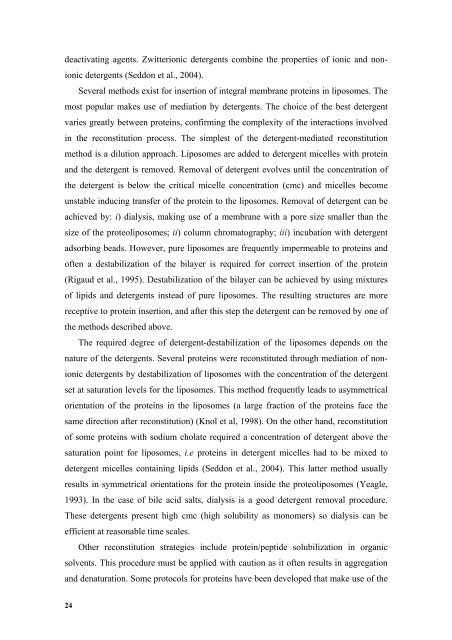Biophysical studies of membrane proteins/peptides. Interaction with ...
Biophysical studies of membrane proteins/peptides. Interaction with ...
Biophysical studies of membrane proteins/peptides. Interaction with ...
You also want an ePaper? Increase the reach of your titles
YUMPU automatically turns print PDFs into web optimized ePapers that Google loves.
deactivating agents. Zwitterionic detergents combine the properties <strong>of</strong> ionic and nonionic<br />
detergents (Seddon et al., 2004).<br />
Several methods exist for insertion <strong>of</strong> integral <strong>membrane</strong> <strong>proteins</strong> in liposomes. The<br />
most popular makes use <strong>of</strong> mediation by detergents. The choice <strong>of</strong> the best detergent<br />
varies greatly between <strong>proteins</strong>, confirming the complexity <strong>of</strong> the interactions involved<br />
in the reconstitution process. The simplest <strong>of</strong> the detergent-mediated reconstitution<br />
method is a dilution approach. Liposomes are added to detergent micelles <strong>with</strong> protein<br />
and the detergent is removed. Removal <strong>of</strong> detergent evolves until the concentration <strong>of</strong><br />
the detergent is below the critical micelle concentration (cmc) and micelles become<br />
unstable inducing transfer <strong>of</strong> the protein to the liposomes. Removal <strong>of</strong> detergent can be<br />
achieved by: i) dialysis, making use <strong>of</strong> a <strong>membrane</strong> <strong>with</strong> a pore size smaller than the<br />
size <strong>of</strong> the proteoliposomes; ii) column chromatography; iii) incubation <strong>with</strong> detergent<br />
adsorbing beads. However, pure liposomes are frequently impermeable to <strong>proteins</strong> and<br />
<strong>of</strong>ten a destabilization <strong>of</strong> the bilayer is required for correct insertion <strong>of</strong> the protein<br />
(Rigaud et al., 1995). Destabilization <strong>of</strong> the bilayer can be achieved by using mixtures<br />
<strong>of</strong> lipids and detergents instead <strong>of</strong> pure liposomes. The resulting structures are more<br />
receptive to protein insertion, and after this step the detergent can be removed by one <strong>of</strong><br />
the methods described above.<br />
The required degree <strong>of</strong> detergent-destabilization <strong>of</strong> the liposomes depends on the<br />
nature <strong>of</strong> the detergents. Several <strong>proteins</strong> were reconstituted through mediation <strong>of</strong> nonionic<br />
detergents by destabilization <strong>of</strong> liposomes <strong>with</strong> the concentration <strong>of</strong> the detergent<br />
set at saturation levels for the liposomes. This method frequently leads to asymmetrical<br />
orientation <strong>of</strong> the <strong>proteins</strong> in the liposomes (a large fraction <strong>of</strong> the <strong>proteins</strong> face the<br />
same direction after reconstitution) (Knol et al, 1998). On the other hand, reconstitution<br />
<strong>of</strong> some <strong>proteins</strong> <strong>with</strong> sodium cholate required a concentration <strong>of</strong> detergent above the<br />
saturation point for liposomes, i.e <strong>proteins</strong> in detergent micelles had to be mixed to<br />
detergent micelles containing lipids (Seddon et al., 2004). This latter method usually<br />
results in symmetrical orientations for the protein inside the proteoliposomes (Yeagle,<br />
1993). In the case <strong>of</strong> bile acid salts, dialysis is a good detergent removal procedure.<br />
These detergents present high cmc (high solubility as monomers) so dialysis can be<br />
efficient at reasonable time scales.<br />
Other reconstitution strategies include protein/peptide solubilization in organic<br />
solvents. This procedure must be applied <strong>with</strong> caution as it <strong>of</strong>ten results in aggregation<br />
and denaturation. Some protocols for <strong>proteins</strong> have been developed that make use <strong>of</strong> the<br />
24















